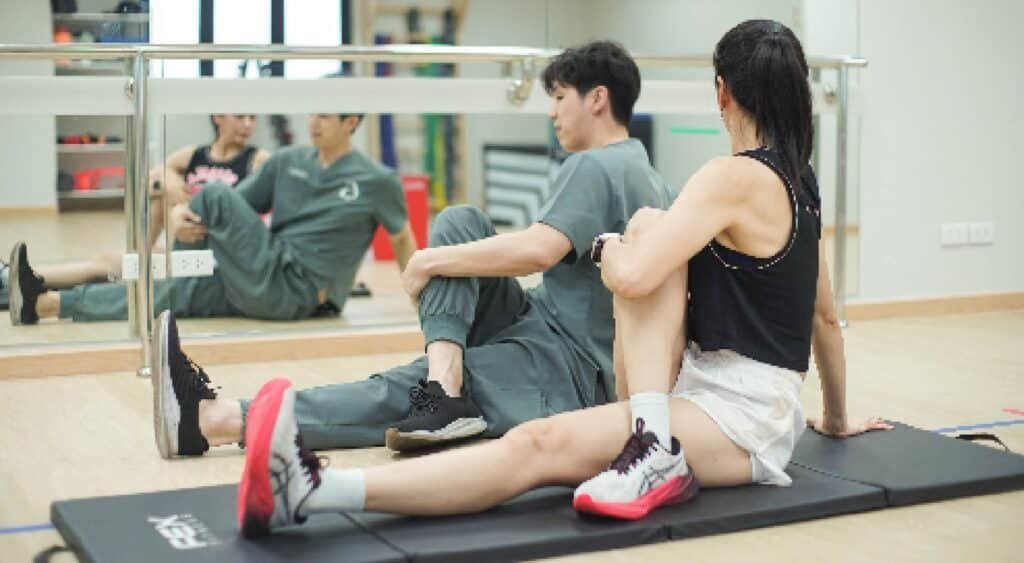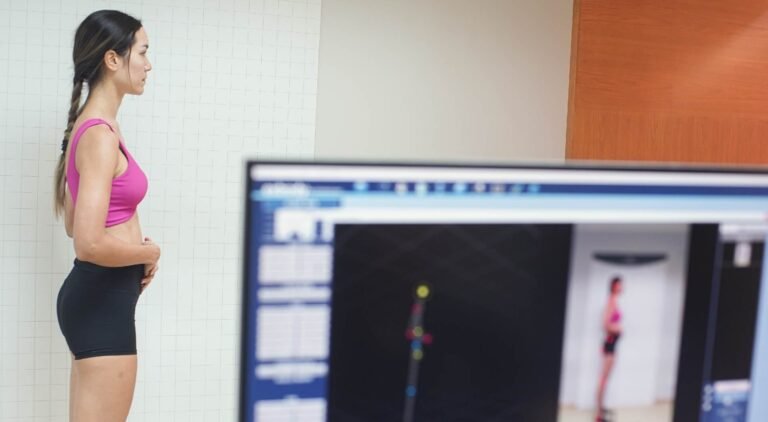The sacral vertebrae are key to our spinal health. They sit at the spine’s base, supporting our lower back. At Greenbell Physical Therapy Clinic in Thailand, we stress the need to know about sacral structure for better spinal health.
The sacrum, formed by five fused vertebrae, is a vital part of our body’s structure. It carries the weight of our upper body to the pelvis and legs. This setup ensures stability when standing and allows for movement.
Knowing about sacral anatomy is crucial for those with lower back problems. It helps find the cause of pain and shapes treatment plans. Our team at Greenbell focuses on this area to offer specific care for spinal conditions.

Key Takeaways
- Sacral vertebrae are located at the base of the spine
- They connect the spine to the pelvis
- The sacrum consists of five fused vertebrae
- It plays a crucial role in weight distribution
- Understanding sacral anatomy aids in treating lower back issues
Anatomy of the Sacral Vertebrae: Essential Components
The sacral vertebrae are key parts of our spine. They are fused bones that support our body weight and link the spine to the pelvis. Let’s look at the main parts of sacral anatomy.
Structure and Composition of Sacral Bones
The sacrum is made of five fused vertebral bodies. Unlike other spine parts, these bones merge into a single, triangular shape. This shape adds strength and stability to the lower back. The sacrum does not have intervertebral discs, unlike other spine segments.
Anatomical Landmarks and Features
The sacrum has several unique features:
- Sacral promontory: The upper edge that connects to the lumbar spine
- Sacral foramina: Small openings for nerves to pass through
- Sacral canal: A central channel housing the spinal cord’s end
- Sacral hiatus: An opening at the bottom of the sacrum
These landmarks help doctors at Greenbell Physical Therapy Clinic diagnose and treat sacral issues.
Nerve Pathways Through the Sacrum
The sacrum has important nerve roots. These nerves exit through the sacral foramina, controlling lower body functions. The sacroiliac joint, where the sacrum meets the ilium bone, is a key area for nerve interaction. Knowing these pathways is key for addressing pain and mobility issues in the lower back and legs.
The Role of Sacral Vertebrae in Spinal Support
The sacral vertebrae are key to keeping our spine stable and our body supported. These bones fuse together to form the sacrum. It’s a strong base that links the lumbar spine to the pelvic girdle. This setup helps spread out weight and forces from the upper body to the lower limbs.
At Greenbell Physical Therapy Clinic in Thailand, we know how crucial sacral health is. The sacrum acts as a keystone, passing forces from the spine to the pelvis and legs. This is vital for walking, running, and lifting.
“The sacrum is the unsung hero of our skeletal system, silently supporting our every move.”
The sacral vertebrae help keep the spine stable in several ways:
- They provide a solid base for the lumbar spine.
- They connect the spine to the pelvic girdle.
- They distribute weight evenly across the pelvis.
- They absorb shock during movement.

Knowing how the sacrum works helps us see its big impact on our daily lives. A healthy sacrum keeps the spine and pelvis aligned right. This promotes good posture and lowers the chance of lower back pain.
| Function | Impact on Body |
|---|---|
| Weight-bearing | Supports upper body weight |
| Force distribution | Transfers loads between spine and legs |
| Stability | Anchors spinal muscles and ligaments |
| Protection | Shields nerves in the spinal canal |
By understanding the sacrum’s role, we can take steps to keep it healthy. This ensures our spine stays stable and we stay well.
Connection Between Sacral Vertebrae and Pelvic Girdle
The sacral vertebrae are key in linking the spine to the pelvic girdle. This connection is crucial for stability and movement in the lower back. Knowing about this link helps in tackling lower back pain and mobility issues.
Sacroiliac Joint Mechanics
The sacroiliac joint connects the sacrum to the ilium of the pelvis. It allows for some movement but is vital for absorbing shock and transferring loads. The joint’s unique shape helps in its stability and function during weight-bearing activities.
Ligament Attachments and Support
Strong ligaments surround the sacroiliac joint, offering vital support to the pelvic girdle. These ligaments keep the joint stable and prevent too much movement. The interosseous and posterior sacroiliac ligaments are especially important in stabilizing the joint during activities.
Weight Distribution Patterns
The sacral vertebrae and pelvic girdle work together to distribute body weight effectively. This is key for balance and reducing stress on the lower back. Proper alignment ensures optimal weight transfer and lowers the risk of pain or injury.
| Structure | Function | Impact on Lower Back |
|---|---|---|
| Sacroiliac Joint | Shock absorption, load transfer | Stabilizes lower back during movement |
| Ligaments | Joint support, movement limitation | Prevents excessive stress on lower back |
| Pelvic Girdle | Weight distribution, balance | Reduces strain on lower back muscles |
At Greenbell Physical Therapy Clinic in Thailand, we focus on sacroiliac joint and pelvic girdle issues. Our expert therapists use specific techniques to enhance joint function and reduce lower back pain.
Common Conditions Affecting the Sacral Region
The sacral vertebrae are key to our spinal health. Problems in this area can cause a lot of pain and make it hard to move. Let’s look at some common issues that affect the sacral region.
Sacroiliac joint dysfunction happens when the joint between the sacrum and pelvis gets inflamed or out of place. This can lead to lower back pain and make simple tasks like walking or climbing stairs hard.
Sacral fractures are less common but can occur from big injuries or weak bones. These fractures cause a lot of pain in the lower back and buttocks.
Coccydynia, or tailbone pain, affects the coccyx, the small bone at the base of the spine. This condition makes sitting very uncomfortable and can be caused by falls or too much pressure on the area.

| Condition | Symptoms | Causes |
|---|---|---|
| Sacroiliac Joint Dysfunction | Lower back pain, stiffness | Misalignment, inflammation |
| Sacral Fractures | Severe lower back pain | High-impact injuries, osteoporosis |
| Coccydynia | Tailbone pain, discomfort while sitting | Falls, prolonged pressure |
At Greenbell Physical Therapy Clinic in Thailand, we focus on treating sacral region issues. Our team knows how complex these problems can be. We create custom treatment plans to help ease pain and improve function.
Treatment Options at Greenbell Physical Therapy Clinic
At Greenbell Physical Therapy Clinic in Thailand, we specialize in sacral-related issues. Our team uses effective methods to tackle lower back pain and sacroiliac joint problems.
Physical Therapy Approaches
We focus on sacral vertebrae issues with our physical therapy. We design personalized plans to boost mobility and cut down discomfort. These plans might include exercises to strengthen core muscles and improve lower back flexibility.
Manual Therapy Techniques
Our skilled therapists apply hands-on methods for sacroiliac joint dysfunction. These techniques include:
- Gentle mobilization of the sacroiliac joint
- Soft tissue massage to relax tight muscles
- Myofascial release to improve tissue flexibility
Rehabilitation Protocols
We create detailed rehab plans for sacral injury recovery. These plans often mix:
- Gradual strength training
- Balance and coordination exercises
- Posture correction techniques
Our aim is to restore function and prevent future issues in the lower back and sacral area.
At Greenbell, we’re dedicated to delivering excellent physical therapy. Our treatments aim to reduce pain, enhance mobility, and improve overall life quality for those with sacral vertebrae problems.
Relationship Between Sacral Vertebrae and Lower Back Health
The sacral vertebrae are key to lower back health. Knowing how they work can help avoid pain and boost well-being. The sacrum supports the upper body and helps transfer weight to the legs.
Impact on Posture
Good posture starts with the sacral vertebrae. If they’re not aligned right, it can upset the pelvis. This imbalance can strain the lower back muscles.
Movement Patterns
The sacrum shapes how we move. It connects the spine to the pelvis, affecting our walk and movement. Healthy sacral vertebrae mean smooth, pain-free daily activities.

Pain Management Strategies
Sacral problems can lead to lower back pain. Greenbell Physical Therapy Clinic in Thailand has ways to handle this:
- Targeted exercises to strengthen core muscles
- Manual therapy to improve sacral mobility
- Posture correction techniques
- Education on proper body mechanics
| Sacral Health | Lower Back Impact |
|---|---|
| Proper alignment | Reduced pain, improved posture |
| Misalignment | Increased pain, poor posture |
| Good mobility | Smooth movement patterns |
| Restricted mobility | Limited range of motion |
Fixing sacral vertebrae health can solve many lower back problems. Regular care keeps the spine working well and boosts overall health.
Preventive Care and Maintenance for Sacral Health
Keeping your sacral vertebrae healthy is crucial for a strong lower back and spine. At Greenbell Physical Therapy Clinic in Thailand, we stress the need for preventive care. This helps keep your sacral area in great shape.
Good posture is essential for sacral health. Sit straight with your shoulders back and spine aligned. When standing, spread your weight evenly on both feet. These actions lessen stress on your sacral vertebrae and improve spinal health.
Regular exercise also strengthens the muscles around your sacral area. Try these simple exercises:
- Pelvic tilts
- Gentle back stretches
- Core-strengthening activities
Ergonomics are important too. Make your workspace spine-friendly. Use a chair with good lumbar support and keep your computer screen at eye level. This avoids strain on your lower back.
Keeping a healthy weight is also key. Extra pounds can put pressure on your sacral vertebrae. This can cause pain and discomfort in your lower back.
| Activity | Benefit for Sacral Health |
|---|---|
| Swimming | Low-impact exercise that strengthens back muscles |
| Yoga | Improves flexibility and posture |
| Walking | Promotes blood flow to spinal structures |
Prevention is always better than cure. By following these tips, you can keep your sacral health in top condition. This helps avoid future problems.
Exercise and Strengthening Programs for Sacral Support
Keeping your sacral area strong and flexible is key to a healthy lower back. At Greenbell Physical Therapy Clinic in Thailand, we offer tailored programs to boost sacral support and improve pelvic girdle function.
Core Strengthening Exercises
Strong core muscles help stabilize the sacroiliac joint and lower back. Try these exercises:
- Planks: Hold for 30 seconds, gradually increasing time
- Bird-dog: Alternate arm and leg lifts while on hands and knees
- Bridges: Lift hips while lying on your back, feet flat on the floor
Flexibility Training
Stretching improves mobility in the sacral region and pelvic girdle. Include these stretches:
- Piriformis stretch: Seated figure-four position
- Cat-cow: Alternate arching and rounding your back on hands and knees
- Child’s pose: Gentle stretch for the lower back and hips
Stabilization Techniques
These exercises enhance sacroiliac joint stability:
- Pelvic tilts: Subtle movements to engage core and pelvic muscles
- Single-leg balance: Stand on one leg, holding for 30 seconds
- Clamshells: Lie on your side, open and close knees while keeping feet together
| Exercise Type | Frequency | Sets | Reps/Duration |
|---|---|---|---|
| Core Strengthening | 3-4 times/week | 3 | 10-15 reps |
| Flexibility Training | Daily | 2-3 | 30 seconds hold |
| Stabilization Techniques | 4-5 times/week | 2-3 | 12-15 reps |
Remember, consistency is crucial for sacral health. Start slowly and increase intensity as you build strength and flexibility in your lower back and pelvic area.
Conclusion
The sacral vertebrae are key to our spinal health and overall well-being. They form the base of our lower back, linking the spine to the pelvis. Knowing their role helps us see their importance in our daily lives.
The sacrum supports our body weight and allows us to move. It’s essential for many activities, from sitting to running. Problems here can really affect our quality of life.
At Greenbell Physical Therapy Clinic in Thailand, we focus on sacral health. Our team provides custom treatments for sacral issues. We encourage everyone to take care of their sacral health through exercise, good posture, and seeking professional help when needed.





